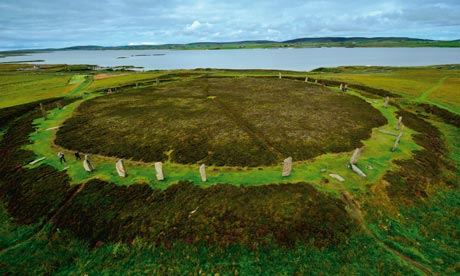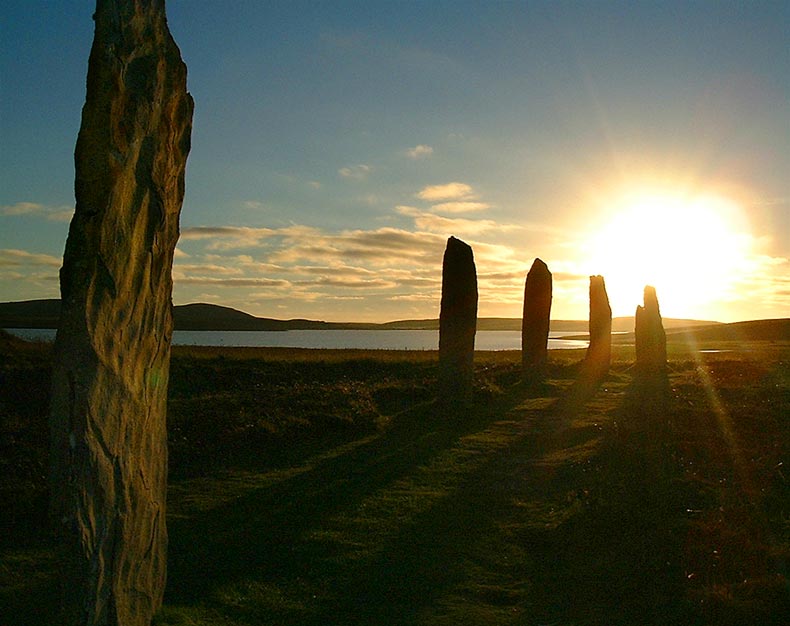Anthropology
Related: About this forum5,000-year-old Neolithic art found in Orkney dig
http://www.scotsman.com/news/scotland/top-stories/5-000-year-old-neolithic-art-found-in-orkney-dig-1-3026157(excerpt)
An intricately-inscribed stone was discovered by excited archaeologists at the Ness of Brodgar on Wednesday.
Nick Card, the excavation team director at the dig – which lies in the heart of Neolithic Orkney, between the Ring of Brodgar and the Stones of Strenness – said the latest find had created a “huge buzz” on the site.
The stone is unusual as it is artistically decorated on both sides and has impressive deep incisions.
Mr Card, of the Orkney Research Centre for Archaeology and based at the University of the Highlands and Islands in the islands, said: “It is perhaps the finest piece of art we have recovered from the site, and one of the finest from the UK ever – amazing and awe-inspiring.”
MORE
(I'd like to see more pics)
Judi Lynn
(160,449 posts)if you check "Ness of Brodgar."
I've been gaping at the images after reading your article. I knew nothing whatsoever about this.
Please take the time to look it up. You could end up reading from the images' links for ages. Very interesting.
[center]



 [/center]
[/center]
Thank you for your post.
theHandpuppet
(19,964 posts)Visiting the Orkneys and its ancient sites has always been on my bucket list, Skara Brae in particular. I knew of the Ring of Brodgar but it seems there are new discoveries all the time. Very exciting! Wouldn't you love to be an archaeologist working up there right now?
alfredo
(60,071 posts)theHandpuppet
(19,964 posts)This is a really good site: http://www.orkneyjar.com/archaeology/
theHandpuppet
(19,964 posts)Here's a sampling from a link at orkneyjar (click on thumbnails for larger images)
http://www.orkneyjar.com/archaeology/dhl/scrapbook/st/index.html
This is my favorite:

matthews
(497 posts)Tyrs WolfDaemon
(2,289 posts)That was from my stone art phase. I think I did it around the same time I erected Stonehenge. I did that one to impress a date  - it didn't work. She said that I should have spent the time on my farm and hunting.
- it didn't work. She said that I should have spent the time on my farm and hunting.  She just didn't understand the art behind all those giant stones and the wood structure around them.
She just didn't understand the art behind all those giant stones and the wood structure around them.
This is a more recent work:


Obviously, I write this in jest and hope that it makes some people at least smile. A small laugh would be good too. 
theHandpuppet
(19,964 posts)Did you create it? Is that limestone?
Tyrs WolfDaemon
(2,289 posts)

I did that one and a few others. I keep meaning to try doing some more. The stone is limestone that I picked up at a garden supply place. The guys there all looked at me funny since I was tapping each one with a hammer in order to pick the ones I wanted. (A good clean ring is a good indication that there aren't fractures that you can't see right away. A dull thud = fractures)
Here are two others that I have pictures of.


theHandpuppet
(19,964 posts)I have an MFA and though I've been trained in a number of disciplines, stone carving has almost become a lost art. So has the kind of printmaking that was my specialty in the old days, when you ground limestone blocks with grit and elbow grease and created prints one at a time with the use of a press. Cincinnati was once known as a major printing center but many of the special limestones used for this purpose are now gone and the remaining ones fetch very high prices. (It takes a rare type of limestone to make the finer prints and most of the blocks came from Europe. The supply has been dwindling for ages.) When the old method of printing gave way to a more mechanized system, the old stones were tossed. For a while people around Cincinnati cannibalized the old stones to create garden walls and such, only to find the beautiful limestone blocks weren't suitable for the outdoors. Within a few winters they learned that these fine grained slabs of limestone absorbed water and in the winter, shattered in freezing temperatures. That's why today there's so few usable stones left. In our ignorance we destroyed much of the remaining supply of limestone used for fine art printmaking. Well, enough prattling on about that.
One of my hobbies, which I pretty much abandoned after I left Ohio, was paleontology. It was an odd mix of study between art and geology, but it suited me fine. As I studied in Cincinnati, you can imagine it was a fossil collector's heaven. Lots of fossil-rich limestone and shale, as well as a particularly beautiful, fine blue shale across the river in Northern KY. You'd find that most of the limestone slabs available to you there would probably contain Ordovician fossils of some kind.
I grew up not far from the Great Serpent Mound, which probably sparked my interest in ancient cultures. The town in which I grew up is dotted with mounds of the Adena people. Among my remaining collection of fossils from that area are some very curious specimens I've never been able to identify, not for the fossils within but because of their composition, very heavy and iron-rich. I think they may be have come from an outlying outcropping of unusual geology in the area of the Serpent Mound crater. I've given away most of my collection of fossils but did hold on to a couple of these specimens, as I am determined to one day find out just what in the hell they are.
Enough of my blathering. Keep up your creative work! It's nice to see someone still practicing the traditional arts. After all, much or even most of what we know today about ancient cultures is thanks to people who worked in stone.
![]()
niyad
(113,049 posts)seriously, you do some wonderful work, and thank you for sharing with us.
Tyrs WolfDaemon
(2,289 posts)the human or the wolf. 
I'm glad people like the carvings. The positive feedback I've gotten is helping to push me to get some more done. ![]()
Lugal Zaggesi
(366 posts)was 40,000 people (biggest city in the world). They had already invented cuneiform writing, and the Bronze Age had started.
Artistically carved stones are nice - but they didn't get the Civilization ball rolling.

Sacred Eanna Precinct in Uruk. Sumer, Mesopotamia, 3000 BC.
theHandpuppet
(19,964 posts)What has always amazed me is that there were people at all in what must have been, at that, time, some pretty inhospitable places in northern climes. For me, the idea of setting up shop in the Orkneys long ago when I could have been living in a place like Uruk -- well, the tracks of human migration have always puzzled me.
I participated in the Genographic Project which tracked my mother's people from the area of modern day Lebanon to where her people eventually ended up, in the old territory of Prussia near the Baltic Sea. The only thing my gr-grandmother had to say about it (she left when a small girl) was that it was so damn cold she was glad to get out. I would imagine winters aren't much better in the Orkneys, which leads me to wonder who the people were that migrated to such a place, and why.
Lugal Zaggesi
(366 posts)But to travel far from your birthplace was probably very, very dangerous for most of History (and prehistory). You're always going through "somebody else's" land, and you have to carry all your offense/defense. Even if you aren't killed on the Journey, trying to start over someplace else is usually frowned upon by the people already living there. Maybe one or two travelers would be welcomed, but a whole Tribe ? That's fightin' talk.
Even the cities of Mesopotamia were no picnic. Sure, they had writing and metallurgy, but also Kings and Priests who were small in number - most people are probably farming half-naked most of their life (and I heard early farmers had lots of malnutrition - farming supported bigger populations, but hunting/gathering had a much better, healthier diet. Cro-Magnons actually had bigger brains than modern Humans). And wars were very frequent in Sumeria (and all of Mesopotamia, later), hence the big walls around every city, and the local god called upon to "defend" them (or help them conquer the blasphemers down the river).
History is written mainly by a very small slice of "elites" (this Great King won this Huge War) - hence events like discovering the "Iceman", a rather regular guy from 3300 BC, is so interesting:
http://en.wikipedia.org/wiki/%C3%96tzi
And it's kind of amazing that there are still Eskimos in the world.
I forgot to mention - people living in Orkney in 3000 BC probably had NO CLUE that there were such things as cities like Uruk 4000 miles to the southeast. They were probably lucky if they had any contact with people living 200 miles away.
theHandpuppet
(19,964 posts)"Outside" as in what you said, anything further than 200 miles away. It's just curious what would drive people to migrate to such a remote, northerly location as the Orkneys. I would assume their diet was quite different from that of people in more temperate climes, too. I wonder if the ancient remains provide any clue as to how healthy this population was. I need to fully explore those links on Orkney archaeology.
One of the primary reasons I participated in the genographic project is that human migration has always been a subject that intrigues me.
I've seen a documentary on the Iceman, which was truly fascinating. Only wish we had more shows like that. As it is, my cable package only offers up the History Channel, where I can learn about ancient archaeological sites and cultures only by sitting through programs about UFOs. Sheesh. No wonder people have turned to other sources, particularly the internet, to get their information.
SunSeeker
(51,508 posts)I'd love to see a post (hint hint) explaining human migration--or even just a map illustrating it.
![]()